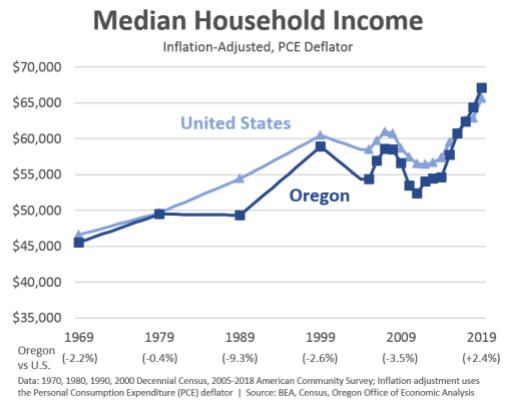What City Observatory did this week
How Portland powered Oregon’s economic success. After decades of lagging the nation, Oregon’s income now exceeds the national average. While some seem to think its a mystery: It’s not. It all about a flourishing Portland economy, especially in the central city of the region. This success has been powered by an influx of talent, especially well-educated young adults drawn to close-in urban neighborhoods.
Income growth in Multnomah County accounts for essentially all of the net improvement in Oregon incomes relative to the nation over the past decade or more. Rising incomes, especially in the city, have markedly reduced racial and ethnic income gaps. The secrets of economic success: talent, quality of life, urban amenities, and knowledge industry clusters.
Must read
The inequity and economic irrationality of urban freeway construction. In a precise and trenchant analysis for the Toronto Globe and Mail, Todd Litman eviscerates the economics and rationale for expensive urban freeways. The province of Ontario is proposing to spend billions to widen major highways in the Toronto region, in the futile attempt to reduce congestion, which as Litman shows, can never be accomplished by adding more capacity.
Litman’s analysis cuts through to two key economic facts: Wider urban roads cost vastly more than any of their users would willingly pay or their use. As he points out:
Also, new highways are far more expensive than most people realize, typically costing tens of millions of dollars for each kilometre of lane. Considering land, construction and additional operating expenses, the cost-recovery price for additional highway capacity – the toll required to repay its incremental costs – is typically 50 cents to $2.00 per vehicle-kilometre, far more than what motorists pay in fuel taxes.
As we’ve pointed out at City Observatory, any time highway users are asked to pay even a small fraction of the costs of these roads, demand evaporates. In a very real sense, the only reason people use new freeway capacity is because somebody else pays for it. In the aggregate, freeway widening is a value-destroying proposition: the costs of additional capacity exceed, by perhaps an order of magnitude the value the users place on capacity. This is the real “equity” problem in transportation: taxing everyone to provide a largely illustory benefit to a few. Again, Litman:
As a result, projects such as Highway 413 represent a huge public subsidy to a relatively small number of future users. Although the Ontario government provides no economic analysis, these projects are likely to cost billions of dollars to build and benefit only a tiny portion of Ontario residents. Anybody who will not drive regularly on these new facilities should protest this inequity.
Freeways are still destroying urban neighborhoods. The role that freeway construction played in destroying city neighborhoods, and especially the homes of people of color is oft-told, but it’s often treated as something that occurred in the distant past. Writing the LA Times, Liam Dillon shows that the highway onslaught is ongoing, and that new and expanded freeways have wiped out tens of thousands of homes.
. . . that widenings, extensions and other freeway construction continue to take a significant toll on communities even now. More than 200,000 people have lost their homes nationwide to federal road projects over the last three decades, according to a Times analysis of federal transportation data. The actual total is higher because many states fail to report how many homes are taken annually.
It’s also worth remembering that the direct destruction of homes and businesses due to freeway construction is just the first effect. The added volume of traffic makes these neighborhoods more polluted and less livable. Academic research has shown that population loss continues for decades after freeway construction in urban neighborhoods.
New Knowledge
Subsidies for homeownership encourage sprawl and damage cities. For decades, the US has offered generous subsidie to homeownership, and granted preferential treatment to new housing. These benefits have not flowed similarly to renters or to existing housing. As a practical matter, the subsidies disproportionately benefit new suburban greenfield development (as has highway construction). The result is that public policy is tilted highly toward sprawl. A key component of this is the favorable tax treatment provided to homeownership.
The study takes advantage of a kind of natural experiment afforded by the repeal of a German homeownership subsidy in 2005. Up until that date, homeowners could qualify for a special tax credit for the purchase of a home which provided, over eight years, a subsidy equal to about one-sixth the price of a home. Because—as in the US—owner-occupied housing, especially newer units, is located in suburban rather than city locations, the availability of the credit pushed households to choose more suburban locations. The authors show that when the credit was repealed, there was an immediate and noticeable re-centralization of population.
Germany’s cities have re-centralized conspicuously ever since the subsidy was repealed. Controlling for distance from the city center and for various fixed effects, population in every central ring (i.e. a ring among the third of rings closest to the center) grew by 5% between 2005 and 2017; while population in every peripheral ring (i.e. a ring among the two thirds of rings closer to the urban fringe) contracted by 2% over the same period.
The author’s estimate that repeal of the homeownership subsidy resulted in about 200,000 fewer housing units in suburbs and about the same amount of new housing in cities, over a period of a years. Subsidies for homeownership, given the nature of the housing market, are anti-city. This evidence puts the lie to claims about suburbs (and homeownership) representing the revealed preference of consumers. Instead, it shows that public policies, especially the tax code, push people to choose suburban locations, and undermine cities.
Daminger, Alexander; Dascher, Kristof (2021) : Homeowner Subsidy Repeal and Housing Recentralization, Beiträge zur Jahrestagung des Vereins für Socialpolitik 2021: Climate Economics, ZBW – Leibniz Information Centre for Economics, Kiel, Hamburg
In the news

